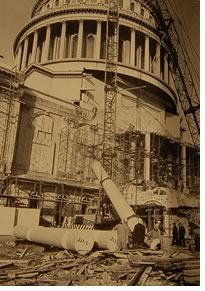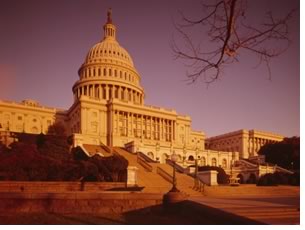

Congressional advocacy puts architects’ issues on national stage
by Tracy Ostroff
With great prescience, AIA Secretary Glenn Brown, FAIA, a founding
member of the Washington Chapter of the American Institute of
Architects, urged the society to relocate to the nation’s
capital from its New York City headquarters. In D.C., Brown and his
contemporaries reasoned, the Institute could influence federal
building efforts and funding. Members considered other locations,
but ultimately chose Washington, D.C., in 1898 for its political
access and ties to money and power.
 Brown was
tapped to become executive secretary of the AIA when it moved to
Washington and into the Octagon House. During Brown’s tenure,
the Institute was instrumental in consolidating the McMillan
Commission (also know as the Senate Park Commission) plan for
Washington and ensuring that it became a reality, a history of the
AIA notes. This plan reasserted the open spaces and planning
concepts of the 18th-century L’Enfant plan. In addition, the
commission envisioned complexes for government buildings in the
Federal Triangle and around the Mall and Lafayette Square.
Brown was
tapped to become executive secretary of the AIA when it moved to
Washington and into the Octagon House. During Brown’s tenure,
the Institute was instrumental in consolidating the McMillan
Commission (also know as the Senate Park Commission) plan for
Washington and ensuring that it became a reality, a history of the
AIA notes. This plan reasserted the open spaces and planning
concepts of the 18th-century L’Enfant plan. In addition, the
commission envisioned complexes for government buildings in the
Federal Triangle and around the Mall and Lafayette Square.
The Institute was also instrumental in the formation of and
appointments to the U.S. Commission of Fine Arts, established in
1910. Today, this body continues to advise the federal government
on matters of art and architecture that affect the appearance and
workings of the nation’s capital. The McMillan Plan and the
Fine Arts Commission were significant factors in the development of
Washington during the 20th century. In asserting its role on the
national stage, the AIA played a key part in construction of the
Lincoln Highway, advocacy for the Appalachian Trail, and support
for the Vietnam Veterans Memorial designed by Maya Lin. Most
recently, the AIA has lobbied for school construction funding,
brownfields legislation, and state licensure issues and has taken a
leading role in combining security concerns with architectural
aesthetics.
A brief snapshot of 10 areas of congressional activity over the
past few decades offers a glimpse at the sustained vibrancy of the
relationship between the Institute and the legislative branch and
helps frame how the AIA’s values and public policies influence
the lives of all Americans.
Americans with Disabilities Act. The AIA
“played a significant role in developing the ADA legislation,
initiating and shaping a number of provisions that should make the
law more workable for architects, employers, and building owners.
Those provisions include the treatment of historic properties,
alterations to existing buildings, and the alignment of existing
state and local buildings codes with the act,” writes the
editor of Architecture magazine in 1990. The AIA
Memo reported, “The ADA will have a profound impact on
the design and construction of new public and commercial buildings,
as well as the alteration of existing structures. The act is
designed to end discrimination of people with disabilities in
employment and at workplaces.
 Over the past
two decades, the AIA has taken steps to help architects play key
roles in implementing the law by providing significant technical
information and assistance in print and digital media. At the
10-year anniversary of the law, the AIA presented substantial
comments on proposed changes to the ADA. The Institute continues to
work collaboratively with the U.S. Department of Justice as it
continues its commitment to ensuring that the Americans with
Disabilities Act Accessibility Guidelines (ADAAG) are adopted and
enforced in a way that is “consistent, clear, and
certain.”
Over the past
two decades, the AIA has taken steps to help architects play key
roles in implementing the law by providing significant technical
information and assistance in print and digital media. At the
10-year anniversary of the law, the AIA presented substantial
comments on proposed changes to the ADA. The Institute continues to
work collaboratively with the U.S. Department of Justice as it
continues its commitment to ensuring that the Americans with
Disabilities Act Accessibility Guidelines (ADAAG) are adopted and
enforced in a way that is “consistent, clear, and
certain.”
Copyright protection. Before Congress passed The
Architectural Works Protection Act, U.S. copyright law prohibited
the unauthorized copying of drawings and plans but did not
necessarily prevent the unauthorized construction of a building
from copyrighted plans and drawings. As reported in the December
1990 AIA Memo, the AIA helped secure protections under
federal copyright law for architectural plans and drawings that
enables architects to take action against such infringement of
their designs. The legislation was prompted by a Library of
Congress report that recommended that Congress consider enacting
additional safeguards for works of architecture. The AIA requested
the Library of Congress report. “The protection extends to a
building as a whole, not to its individual elements, thus putting
architectural works on a par with other intellectual property now
protected by U.S. copyright law. Existing copyright law allows
architects to now seek a court injunction against an infringing
building—an important AIA goal,” wrote an AIA Government
Affairs staffer in the January 1991 Memo.
Qualifications-Based Selection. In 1972, Congress
passed AIA-backed legislation, the Brooks Architect/Engineer Act,
known as the Brooks Act, which instructs the federal government to
award A/E contracts using qualifications-based selection (QBS) for
federal contracts. The AIA also helped establish Brooks Act
provisions in the states, with 47 states hiring architects and
engineers by QBS. Since implementation of the act, the AIA has
strongly opposed any legislative or administrative effort to weaken
or limit its application and continues to advocate upholding the
provision of the U.S. Code that requires federal procurement of
architecture and engineering services to be negotiated with the
“highest qualified firm” rather than be awarded to the
lowest bidder. In a March 2005 AIA Angle article, Tom
Wolfe, senior director of Federal Affairs, said “The AIA is a
long-time champion of the Brooks Act and helped to get it passed in
the 1970s. We will continue to fight to ensure that all federal
agencies follow the law and will work with our partners in the
engineering profession to stop any effort to undermine
it.”
 Landmark
transportation legislation. Members of the AIA have long
advocated the link between intelligently designed transportation
projects and a community’s livability. In the early 1990s, the
AIA spearheaded a coalition to link land-use planning with
transportation policy. The Institute hosted a symposium that
resulted in draft legislation that advanced professional interests
in community planning, historic preservation, and landscape
enhancement. Congress passed the transportation plan, which
included several of the AIA’s “Livable Communities”
proposals, including strengthened state and local planning
provisions, a separate funding category for transportation
enhancements, increased funding for mass transit, a national scenic
and historic highway system, and some billboard control reforms.
“The new law holds important meaning for architects in terms
of potential new markets and design and planning more sensitive to
communities and the environment,” noted the Government Affairs
team in 1992.
Landmark
transportation legislation. Members of the AIA have long
advocated the link between intelligently designed transportation
projects and a community’s livability. In the early 1990s, the
AIA spearheaded a coalition to link land-use planning with
transportation policy. The Institute hosted a symposium that
resulted in draft legislation that advanced professional interests
in community planning, historic preservation, and landscape
enhancement. Congress passed the transportation plan, which
included several of the AIA’s “Livable Communities”
proposals, including strengthened state and local planning
provisions, a separate funding category for transportation
enhancements, increased funding for mass transit, a national scenic
and historic highway system, and some billboard control reforms.
“The new law holds important meaning for architects in terms
of potential new markets and design and planning more sensitive to
communities and the environment,” noted the Government Affairs
team in 1992.
The AIA continues its advocacy for smart transportation design. In
2005, Congress passed a nearly $300 billion authorization bill for
highway, public transportation, and road safety projects to fund
these projects through 2009. The bill includes the AIA-sponsored
amendment that calls upon Congress to initiate a national study of
the impact of federal transportation spending on community design,
health, and safety. The U.S. Federal Highway Administration has
awarded the AIA a $2-million contract to study the benefits that
well-designed community transportation projects bring to American
communities. The study, which will be completed by July 2007, will
measure how well-designed transportation projects of various types
promote economic development, protect public health and safety and
the environment, and enhance the architectural design and planning
of communities.
 Housing and
homelessness. After significant cuts to housing funding
during the 1980s, the AIA succeeded in helping to advance
affordable and fair-housing issues in Congress, including
legislation that significantly expanded the ability of individuals
with disabilities and others to gain access to multifamily housing;
overhauling of regulations for housing for the elderly and people
with disabilities; and federal government assistance for state,
local, and private-sector initiatives in construction and
rehabilitation of housing for people with modest incomes. The AIA
also urged Congress to support legislation that would revitalize
historic rehabilitation and low-income housing efforts nationwide,
as reported in various AIA news sources in the late 1980s and early
1990s.
Housing and
homelessness. After significant cuts to housing funding
during the 1980s, the AIA succeeded in helping to advance
affordable and fair-housing issues in Congress, including
legislation that significantly expanded the ability of individuals
with disabilities and others to gain access to multifamily housing;
overhauling of regulations for housing for the elderly and people
with disabilities; and federal government assistance for state,
local, and private-sector initiatives in construction and
rehabilitation of housing for people with modest incomes. The AIA
also urged Congress to support legislation that would revitalize
historic rehabilitation and low-income housing efforts nationwide,
as reported in various AIA news sources in the late 1980s and early
1990s.
Preservation of the West Front of the U.S. Capitol. The AIA led a
coalition of organizations to preserve the historic West
Façade of the U.S. Capitol building. After a decades-long
debate among lawmakers and concerned organizations over whether to
restore or extend the West Front of the U.S. Capitol, the
“architectural integrity” of the West Front was preserved
with a vote in Congress that provided nearly $50 million for the
restoration. The AIA was part of an impassioned lobbying effort to
save the last remaining visible façade of the original
Capitol designed by William Thornton, Benjamin Latrobe, and Charles
Bulfinch, and completed in 1822. The Institute submitted an
appraisal of the conditions of the West Front’s structure and
presented alternatives before congressional committees. The AIA
also advised members of Congress; particularly the late Sen.
Moynihan of New York. Architects wrote letters and protested in at
the Capitol. Newspaper editorials applauded the AIA’s efforts
to preserve a facet of our nation’s history and agreed that
efforts to extend the West Front were foolhardy. In 1983, with the
façade further deteriorating, Congress approved the funds
for the restoration and declined to provide money for an
extension—a victory for the AIA and its allies. President
Reagan signed the legislation July 30, 1983.
 Taxes.
More recently, in October 2004, Congress passed the
“JOBS” tax bill, which included a $358-million tax cut
for architecture and engineering firms. Making sure A/E firms were
included in the legislation was a priority item on the AIA’s
federal issues agenda. The law gave firms an across-the-board
9-percent tax deduction that will be phased-in over six years. AIA
members saw their first benefit from the tax cut legislation when
they file their 2005 returns this winter and spring. To help
architects understand how the new tax law would affect their
businesses, the AIA provided a guidance document to help prepare
their returns for the 2005 tax year.
Taxes.
More recently, in October 2004, Congress passed the
“JOBS” tax bill, which included a $358-million tax cut
for architecture and engineering firms. Making sure A/E firms were
included in the legislation was a priority item on the AIA’s
federal issues agenda. The law gave firms an across-the-board
9-percent tax deduction that will be phased-in over six years. AIA
members saw their first benefit from the tax cut legislation when
they file their 2005 returns this winter and spring. To help
architects understand how the new tax law would affect their
businesses, the AIA provided a guidance document to help prepare
their returns for the 2005 tax year.
School construction and renovation. In 2000,
members of the AIA Executive Committee joined President Bill
Clinton, key members of his cabinet, and congressional leaders on
the South Lawn of the White House to support proposed funding for
school construction. The bill, known as the America’s Better
Classroom Act, made federal funds available in the form of tax
credits. The AIA created the “One Room Schoolhouse”
brochure to aid AIA members in their lobbying efforts.
Building Performance. If the adage,
“everything old is new again,” this legislative agenda
item may sound familiar. With skyrocketing energy cost gripping a
nation, and President Jimmy Carter asking all Americans to protect
precious resources, the AIA launched a crusade for energy
conservation in buildings. It urged support of legislation that
would authorize development of energy standards for new
construction and federal loans and subsidies to building owners to
help pay for energy-saving equipment and design, reports a 1976
AIA Memo. In 1977, the AIA publication reported that two
days after Carter asked the nation to lower their thermostats and
start conserving energy, the AIA was on Capitol Hill with a
proposal for Congress that funds from pending economic stimulus
package be earmarked for energy conservation in buildings. In the
months to follow, AIA leaders would meet with White House and
congressional staff to advocate a comprehensive and equitable
national energy policy.
 In 1979, the
AIA Board endorsed the U.S. Department of Energy’s proposed
building energy performance standards (BEPS) as a “major step
toward achieving the nation’s goal of energy
self-sufficiency,” a position that won accolades from DOE
administrators. In 1980, the Institute reiterated its support for
“conservation strategies in the design of new buildings.”
Retrofitting techniques for existing buildings and the application
of renewable resources technologies offered the single greatest
opportunity to increase energy supplies in the 1980s. That would
also include solar projects and building energy research. The
AIA’s advocacy would inform executive decision making and
congressional legislation during the 1980s and 90s.
In 1979, the
AIA Board endorsed the U.S. Department of Energy’s proposed
building energy performance standards (BEPS) as a “major step
toward achieving the nation’s goal of energy
self-sufficiency,” a position that won accolades from DOE
administrators. In 1980, the Institute reiterated its support for
“conservation strategies in the design of new buildings.”
Retrofitting techniques for existing buildings and the application
of renewable resources technologies offered the single greatest
opportunity to increase energy supplies in the 1980s. That would
also include solar projects and building energy research. The
AIA’s advocacy would inform executive decision making and
congressional legislation during the 1980s and 90s.
Energy standards. Recent energy legislation is an extension of a continuing Institute commitment to preserving our valuable natural resources. President George W. Bush signed legislation in 2005 that contained several “wins” in the energy arena for architects and their clients. An intensive national AIA grassroots advocacy effort was instrumental in obtaining $20 million for construction of a “Sun Wall” at the U.S. Department of Energy headquarters in Washington, D.C. The AIA championed this major federal renewable energy/sustainable design project for more than five years.
The bill also included a photovoltaic energy commercialization
program for the U.S. General Services Administration. The measure,
which will help procure and install solar electric systems in new
and existing federal buildings, was a major part of the AIA’s
federal issues agenda. Since early in the current Congress, the AIA
has worked closely with U.S. Rep. James Oberstar (D-Minn.) to
champion the measure, which aims to jump-start the market for
photovoltaic systems and drive down production costs of
photovoltaic equipment by ensuring a public-sector market. It would
also stimulate the use of life-cycle analysis in federal
procurement.
Copyright 2005 The American Institute of Architects. All rights reserved. Home Page

